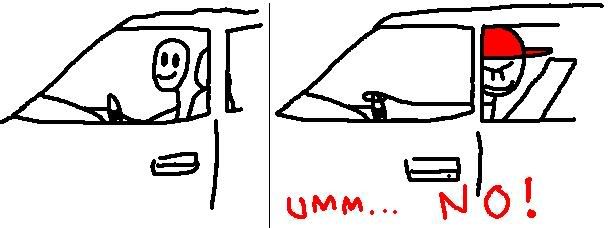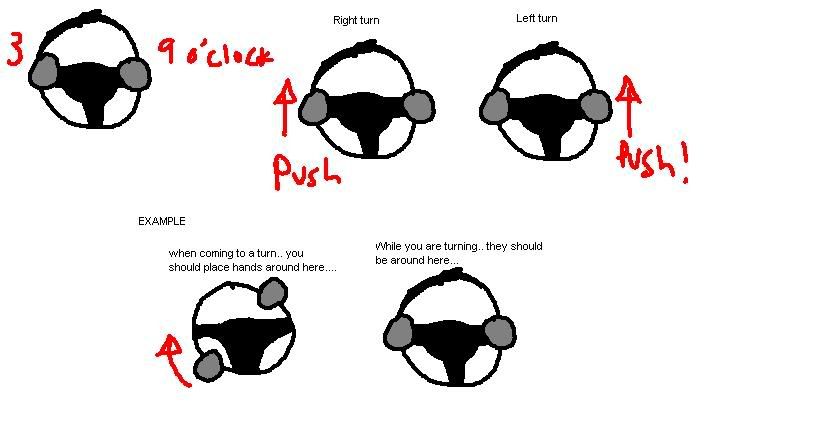Driving… not drifting… but driving… anyways… As you all know… on the road, there are good drivers… and there are bad ones… And knowing everyone here… with their 240’s, 180’s or simply their silvia’s, we know how to take care of our precious babies… but for those of you who dont… this is for you…
There are good and bad drivers correct? dont you hate it when there’s bad drivers everywhere? i do… so im hoping that this thread makes you a better driver… if you already arent one… god knows i hope we all are…
So the basics… if you havent learned it… cuz knowing the USA DMV system doesn’t know how to make a good driver…
Driving position
Ok for all you little kids out there… hence the reason why im posting in the beginner section… don’t be ‘GaNgSta…’ sure you think it looks cool… but it wont help if you crash your lovely 240 that your mom probably bought you… As I was saying… your driving position is imperative. it helps you balance yourself while you balance your car. if the driver cant control his car then god knows how the car will perform…
first… you should be seated upright… Don’t slouch back so far that you can look out the back passanger windows… thats just rediculous… yeah you can see your blind spot better… but you can’t see the road as well as you should…

Ok now your feet… your feet should be compfortable… there should be enough room for your legs to move freely without any difficulty reaching a certain pedal… your left foot should be flat on the dead pedal… the dead pedal is tehre so you can balance your self while momentum is shifting… it helps stabilize your right foot with the throttle and such so you dont jerk or bog the car… learn to love your dead pedal… dont hold it on the or over the clutch… for every second you press the clutch… you kill it 5x’s faster… just a little information…
your arms should be placed at 3 and 9… whether your racing or not… despite the whole 2 and 10 crap… its 3 and 9… your arms should be free enough to move but not too much that its stretched out… your arms shouldnt be locked… try this… sit back… stretch your arms over 2 and 10… the bottem part of your palm and the top of your wrist should be touching 2 and 10… thts how far you should be sitting back… ok now put them on 3 and 9… thats how it should be… yes… yes…
also… when your turning… your arms should relatively be at 3 and 9… coming into a turn… place your hands where you need to so that when you’re turning… they’re at 3 and 9… also… when you’re turning… you should get into the tendency of pushing… not pulling on the steering wheel… i read that its better that way… may not be comfortable… but yeah… i’ll get back to you on the reason why its better when i find out again…
NEXT!
shifting
umm… DOUBLE CLUTCH
is the method of pressing the clutch twice to shift into another gear… this was a method used in old cars because their transmission synchros were not up to date as today’s so you need to clutch twice to actually save it… average lifespan of a tranny at the time of double clutching as about 80k miles… you had to change it once in a cars lifetime… anyways… heres how it goes…
from a gear…
- Clutch in
- drop to neutral
- let go of the clutch
(you can rev match here if you wanted to if downshifting… or upshifting… depending on how bad of a shifter you are…) - clutch again
(you can rev match here also) - put it in gear…
OMG WTF there you go…
double clutching is not a racing technique… dont listen to fast and the furious… bah them… they’re dumb… vin deisal never even double clutched when he drove in that movie…
REV MATCHING
umm… simple… match the rpm of the gear to the speed of the car…
like math…
if you are going 50 mph in 4th gear with 2,000 rpm… and you wanted to downshift into 3rd gear… KNOWing that 3rd gear requires 3,000rpm to go 50 mph… how much do you need to rev?
answer: 1,000 rpm… this might vary… depending on car and settings and stuff… so learn how to do it… it helps you from jerking the car or jake braking… or riding the clutch and stuff…
while doing this… if the car jerks a little… you didnt rev enough… if it pulls a little… you revved too much…
HEEL TOE
or a more modern term BALL AND EDGE
heel toe is a technique of braking while rev matching… thats it… place your toe on the brakes and heel on the throttle… now brake… and just rev match… thats all… its a simple technique… one of the basics… so yeah… shut your pie hole… its not all that great… it is… but its not a big accomplishment if its a basic racing technique…
ball and edge is a term used for heel toe… you basically take the ball… the part under the big toe… put it on the brakes and the edge of your foot… right edge on the throttle… it consists of less movement of the foot and is easier to do with a more modern car where the pedels are much closer…
braking
umm i can’t say much about this… brake… use heel toe if you can… and yeah… one major thing though… LEARN HOW TO THRESHOLD BRAKE!
whether or not you have ABS… threshold braking is a good technique to learn… it shows how well you know the car’s braking limit and such before they lock up… abs kicks in when they lock up… so you would want to know how to threshold break so they wont lock up and abs wont kick in… its a good driving technique… unless you want to drift… then take out your abs and lock your tires as much as you want…
oh yeah… after a race… when you want to turn off your car… park the car… put it in gear… and dont pull the e-brake up… by doing this… your car will be parked and sine the brakes arent engaged… they can cool down better… thats only if you dont want them warped…
hmm other than that… i can’t really think of much to say… um… the rest is working on your line… when to hit the apex and such… knowing when to brake… when to stop braking… when to accelerate… when to not accelerate… when to turn… where the apex is… and so on…
Also… ALWAYS LOOK AT THE ROAD… one of the most obvious things… but you’d be surprised at people when they look at the person in front of them or a bumper or something off to the side…
Common Student Errors
POOR DRIVING POSITION. Check to see that fully depressing the clutch pedal doesn’t require maximum leg extension. Check to see that reaching the steering wheel still leaves a slight bend at the elbow. Check the seat belt and helmet strap.
POOR HAND POSITION. Depending on exact steering wheel design, probably about “10 and 2 o’clock.” Failure to maintain this hand position once on the track: “crossing over” when making turns and not returning to the steering wheel after shifting.
ABRUPT USE OF CONTROLS: steering, brake and throttle. Smoothness is a basic skill/minimum requirement.
INDECISIVE USE OF CONTROLS:
-getting on and off the throttle unnecessarily
-pumping the brakes," lack of effective, consistent brakes.
FAILURE TO USE ALL OF THE TRACK to get biggest (fastest) radius.
“CREEPING IN” from the edge of the track near turn-in point.
EARLY APEXING
–early turn-in caused by too much pressure/over-driving. —failure to recognize the “acuteness” of the corner (angle.)
“DROPPED” CLUTCH AFTER TURN-IN POINT. Too late with all the decisions, putting this one after the turn-in instead of before! Big spin risk if the car’s near the actual limit.
SHIFTING GEARS WHILE IN A CORNER, unnecessary/risky.
FAILURE TO DO MINIMUM CAR PREPARATION. Basic safety demands appropriate tires, suspension and brake pads/brake fluid for usage. Significant re-checking at track (i.e. tire pressure.
“LATE” TURN-IN. Usually caused by failure to recognize that the turn is (probably) less than 90 degrees. Spin risk as student tries to wrestle the car to the proper apex (anyway.)
BRAKING TOO LATE. Problem is worst when consequences are at maximum! Largest errors are made when the difference between straight-away speed and cornering speed is large. Students tend to enter slow turns too fast (and fast turns too slow.)
FAILURE TO BUILD BRAKING (PRESSURE) SMOOTHLY ENOUGH to prevent “locking” of tires. If the fronts lock first, the student will lose steering control. If the rears lock first, there will be immediate directional stability problems.
POOR USE OF RPM’s. Failure to use tachometer to shift neither early or late, missing up or downshifts completely.
FAILURE TO “BALANCE” CAR AT (TURN) ENTRANCE:
-over “rotation” of the car with too much trail-braking and/ or sudden and jerky steering motions. (Oversteer.)
-throttle too soon, no rotation, front “push.” (Understeer.)
TRAILING-THROTTLE OVERSTEER
“Dropping” the throttle abruptly when in the corner. This is an all-to-typical reaction to the mid-corner realization of having made an error. Solution: the idea of “temporarily taking a slightly larger radius.” Suggest to: momentarily steer “out” with a steady throttle.
POWER OVERSTEER. Too much power applied, too abruptly, with car already near critical grip limits. (rear wheel drive)
FAILURE TO RECOGNIZE MISTAKES. Failure to accept the necessity for full concentration and discipline. Symptom: inconsistency.
FAILURE TO ANTICIPATE/AND ADJUST as speed changes require.
you’re welcome to put your input about this… but this bugs me how people want to learn how to race/drift and they don’t even know the basics…
to all beginners… no one starts on top…

 LOL
LOL

